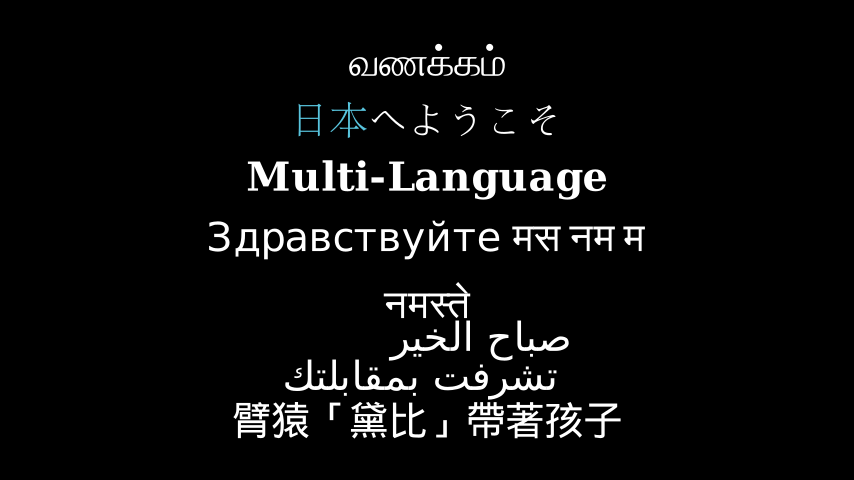Text#
Qualified name: manim.mobject.text.text\_mobject.Text
- class Text(text, fill_opacity=1.0, stroke_width=0, *, color=ManimColor('#FFFFFF'), font_size=48, line_spacing=- 1, font='', slant='NORMAL', weight='NORMAL', t2c=None, t2f=None, t2g=None, t2s=None, t2w=None, gradient=None, tab_width=4, warn_missing_font=True, height=None, width=None, should_center=True, disable_ligatures=False, **kwargs)[source]#
Bases:
SVGMobjectDisplay (non-LaTeX) text rendered using Pango.
Text objects behave like a
VGroup-like iterable of all characters in the given text. In particular, slicing is possible.- Parameters:
text (str) – The text that needs to be created as a mobject.
font (str) – The font family to be used to render the text. This is either a system font or one loaded with register_font(). Note that font family names may be different across operating systems.
warn_missing_font (bool) – If True (default), Manim will issue a warning if the font does not exist in the (case-sensitive) list of fonts returned from manimpango.list_fonts().
fill_opacity (float) –
stroke_width (float) –
color (ParsableManimColor | None) –
font_size (float) –
line_spacing (float) –
slant (str) –
weight (str) –
t2c (dict[str, str]) –
t2f (dict[str, str]) –
t2g (dict[str, tuple]) –
t2s (dict[str, str]) –
t2w (dict[str, str]) –
gradient (tuple) –
tab_width (int) –
height (float) –
width (float) –
should_center (bool) –
disable_ligatures (bool) –
- Returns:
The mobject-like
VGroup.- Return type:
Examples
Example: Example1Text ¶

from manim import * class Example1Text(Scene): def construct(self): text = Text('Hello world').scale(3) self.add(text)
class Example1Text(Scene): def construct(self): text = Text('Hello world').scale(3) self.add(text)Example: TextColorExample ¶

from manim import * class TextColorExample(Scene): def construct(self): text1 = Text('Hello world', color=BLUE).scale(3) text2 = Text('Hello world', gradient=(BLUE, GREEN)).scale(3).next_to(text1, DOWN) self.add(text1, text2)
class TextColorExample(Scene): def construct(self): text1 = Text('Hello world', color=BLUE).scale(3) text2 = Text('Hello world', gradient=(BLUE, GREEN)).scale(3).next_to(text1, DOWN) self.add(text1, text2)Example: TextItalicAndBoldExample ¶

from manim import * class TextItalicAndBoldExample(Scene): def construct(self): text1 = Text("Hello world", slant=ITALIC) text2 = Text("Hello world", t2s={'world':ITALIC}) text3 = Text("Hello world", weight=BOLD) text4 = Text("Hello world", t2w={'world':BOLD}) text5 = Text("Hello world", t2c={'o':YELLOW}, disable_ligatures=True) text6 = Text( "Visit us at docs.manim.community", t2c={"docs.manim.community": YELLOW}, disable_ligatures=True, ) text6.scale(1.3).shift(DOWN) self.add(text1, text2, text3, text4, text5 , text6) Group(*self.mobjects).arrange(DOWN, buff=.8).set_height(config.frame_height-LARGE_BUFF)
class TextItalicAndBoldExample(Scene): def construct(self): text1 = Text("Hello world", slant=ITALIC) text2 = Text("Hello world", t2s={'world':ITALIC}) text3 = Text("Hello world", weight=BOLD) text4 = Text("Hello world", t2w={'world':BOLD}) text5 = Text("Hello world", t2c={'o':YELLOW}, disable_ligatures=True) text6 = Text( "Visit us at docs.manim.community", t2c={"docs.manim.community": YELLOW}, disable_ligatures=True, ) text6.scale(1.3).shift(DOWN) self.add(text1, text2, text3, text4, text5 , text6) Group(*self.mobjects).arrange(DOWN, buff=.8).set_height(config.frame_height-LARGE_BUFF)Example: TextMoreCustomization ¶

from manim import * class TextMoreCustomization(Scene): def construct(self): text1 = Text( 'Google', t2c={'[:1]': '#3174f0', '[1:2]': '#e53125', '[2:3]': '#fbb003', '[3:4]': '#3174f0', '[4:5]': '#269a43', '[5:]': '#e53125'}, font_size=58).scale(3) self.add(text1)
class TextMoreCustomization(Scene): def construct(self): text1 = Text( 'Google', t2c={'[:1]': '#3174f0', '[1:2]': '#e53125', '[2:3]': '#fbb003', '[3:4]': '#3174f0', '[4:5]': '#269a43', '[5:]': '#e53125'}, font_size=58).scale(3) self.add(text1)As
Textuses Pango to render text, rendering non-English characters is easily possible:Example: MultipleFonts ¶

from manim import * class MultipleFonts(Scene): def construct(self): morning = Text("வணக்கம்", font="sans-serif") japanese = Text( "日本へようこそ", t2c={"日本": BLUE} ) # works same as ``Text``. mess = Text("Multi-Language", weight=BOLD) russ = Text("Здравствуйте मस नम म ", font="sans-serif") hin = Text("नमस्ते", font="sans-serif") arb = Text( "صباح الخير \n تشرفت بمقابلتك", font="sans-serif" ) # don't mix RTL and LTR languages nothing shows up then ;-) chinese = Text("臂猿「黛比」帶著孩子", font="sans-serif") self.add(morning, japanese, mess, russ, hin, arb, chinese) for i,mobj in enumerate(self.mobjects): mobj.shift(DOWN*(i-3))
class MultipleFonts(Scene): def construct(self): morning = Text("வணக்கம்", font="sans-serif") japanese = Text( "日本へようこそ", t2c={"日本": BLUE} ) # works same as ``Text``. mess = Text("Multi-Language", weight=BOLD) russ = Text("Здравствуйте मस नम म ", font="sans-serif") hin = Text("नमस्ते", font="sans-serif") arb = Text( "صباح الخير \n تشرفت بمقابلتك", font="sans-serif" ) # don't mix RTL and LTR languages nothing shows up then ;-) chinese = Text("臂猿「黛比」帶著孩子", font="sans-serif") self.add(morning, japanese, mess, russ, hin, arb, chinese) for i,mobj in enumerate(self.mobjects): mobj.shift(DOWN*(i-3))Example: PangoRender ¶
from manim import * class PangoRender(Scene): def construct(self): morning = Text("வணக்கம்", font="sans-serif") self.play(Write(morning)) self.wait(2)
class PangoRender(Scene): def construct(self): morning = Text("வணக்கம்", font="sans-serif") self.play(Write(morning)) self.wait(2)Tests
Check that the creation of
Textworks:>>> Text('The horse does not eat cucumber salad.') Text('The horse does not eat cucumber salad.')
Methods
Initializes the colors.
Attributes
animateUsed to animate the application of any method of
self.animation_overridescolordepthThe depth of the mobject.
fill_colorIf there are multiple colors (for gradient) this returns the first one
font_sizehash_seedA unique hash representing the result of the generated mobject points.
heightThe height of the mobject.
n_points_per_curvesheen_factorstroke_colorwidthThe width of the mobject.
- _find_indexes(word, text)[source]#
Finds the indexes of
textinword.- Parameters:
word (str) –
text (str) –
- _original__init__(text, fill_opacity=1.0, stroke_width=0, color=None, font_size=48, line_spacing=- 1, font='', slant='NORMAL', weight='NORMAL', t2c=None, t2f=None, t2g=None, t2s=None, t2w=None, gradient=None, tab_width=4, warn_missing_font=True, height=None, width=None, should_center=True, disable_ligatures=False, **kwargs)#
Initialize self. See help(type(self)) for accurate signature.
- Parameters:
text (str) –
fill_opacity (float) –
stroke_width (float) –
color (Optional[Union[ManimColor, int, str, Tuple[int, int, int], Tuple[float, float, float], Tuple[int, int, int, int], Tuple[float, float, float, float], ndarray[Any, dtype[int64]], ndarray[Any, dtype[float64]]]]) –
font_size (float) –
line_spacing (float) –
font (str) –
slant (str) –
weight (str) –
t2c (dict[str, str]) –
t2f (dict[str, str]) –
t2g (dict[str, tuple]) –
t2s (dict[str, str]) –
t2w (dict[str, str]) –
gradient (tuple) –
tab_width (int) –
warn_missing_font (bool) –
height (float) –
width (float) –
should_center (bool) –
disable_ligatures (bool) –
- Return type:
None
- _set_color_by_t2c(t2c=None)[source]#
Sets color for specified strings.
Attention
Deprecated The method Text._set_color_by_t2c has been deprecated since v0.14.0 and is expected to be removed after v0.15.0. This was internal function, you shouldn’t be using it anyway.
- _set_color_by_t2g(t2g=None)[source]#
- Sets gradient colors for specified
strings. Behaves similarly to
set_color_by_t2c.
Attention
Deprecated The method Text._set_color_by_t2g has been deprecated since v0.14.0 and is expected to be removed after v0.15.0. This was internal function, you shouldn’t be using it anyway.
- _text2hash(color)[source]#
Generates
sha256hash for file name.- Parameters:
color (ManimColor) –
- _text2settings(color)[source]#
Converts the texts and styles to a setting for parsing.
- Parameters:
color (str) –
- _text2svg(color)[source]#
Convert the text to SVG using Pango.
- Parameters:
color (ManimColor) –